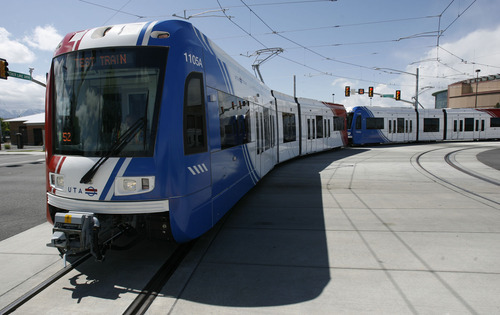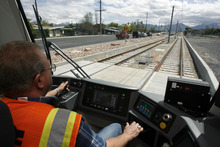This is an archived article that was published on sltrib.com in 2011, and information in the article may be outdated. It is provided only for personal research purposes and may not be reprinted.
Raquel Lubbers is excited about the new TRAX lines opening on Sunday. She says they will make it much easier to travel from her home in the Daybreak area of South Jordan to distant downtown Salt Lake City to take her children to museums or to meet her husband there for an after-work date.
"The new TRAX line will give us more freedom to enjoy our lives," she said. "We're looking forward to skipping the traffic jams and getting around more by rail" from her suburb that suddenly is much more convenient to the rest of the Wasatch Front.
The new Mid-Jordan and West Valley City extensions of TRAX are literally changing the face of transit in Salt Lake County. They will nearly double the miles of track in the TRAX system and more than double the number of train cars in service.
But to afford operating all those new trains, the Utah Transit Authority is cutting its bus service by 10 percent, effective Sunday. Also, 90 percent of all Salt Lake County bus routes will change as UTA cuts, shortens or combines them to mesh with the new TRAX lines.
With all that, the UTA is expecting some confusion on Monday, the first workday when all the changes hit. It will have extra workers at new train stations and key transfer points to help people make connections and to answer questions.
Following is information to help maneuver the revamped transit system.
How to plan travel • Detailed maps and schedules about all the changes are available at UTA's website, rideuta.com.
Also available there is a feature titled, "Plan your trip online." It allows travelers to enter a starting point, a destination and desired time of arrival or departure. The computer will give several options and directions for point-by-point travel through the system.
Riders will find that most long-distance buses from southern and western suburbs to downtown Salt Lake City have been eliminated and been converted or combined into shorter routes that will take them to new TRAX lines.
New TRAX route names • With the addition of the new TRAX extensions, TRAX is beginning to use color-coded names for its lines.
The red line will travel from the University of Utah (the color name choice there was intentional) to Daybreak in South Jordan. It includes the new $535 million Mid-Jordan extension, which runs 10.6 miles from Daybreak to Murray. The extension is expected to carry 9,000 people daily.
The green line will travel from Valley Fair Mall in West Valley City to the Salt Lake Central Station for now. It includes the $370 million West Valley City extension, which runs 5.1 miles from near Valley Fair Mall to the Central Pointe Station at 2100 South. That green line eventually will run to Salt Lake City International Airport. It is expected to carry about 5,000 people a day initially.
The blue line will travel between the Salt Lake Central Station to Sandy and eventually will extend to Draper.
Disappearing will be some TRAX trains that had traveled directly from Sandy to the University of Utah. Such travel will now require a transfer between the blue and red lines. Also disappearing are university trains that had traveled directly to such downtown areas as Temple Square of the Gateway. That will now require a transfer from the red to the green or blue lines.
Transfers on TRAX • It is possible to transfer between TRAX trains at any station shared by those lines.
For example, the red, green and blue lines share all the stations between Central Pointe Station at 2100 South and the Courthouse Station at 450 S. Main. Some lines share other stations as well. Simply exit a train at any of those stations and wait on the platform for a train from the other desired route. Signs on the incoming trains say what line they serve.
So, for example, someone wanting to travel from West Valley City to the University of Utah would need to exit a green line train to take a red line train on any of the stations those two lines share between the Central Pointe and Courthouse stations.
Transfers between bus and TRAX • Passengers boarding a bus can request a transfer slip that allows them to transfer to another bus or TRAX train for two hours from the time of issuance.
TRAX tickets also are good for transfers to buses for two hours from the time of issuance.
TRAX frequency • Trains on each line run every 15 minutes on weekdays from roughly 5 a.m. to 11 p.m. On weekends, trains come every 20 minutes from roughly 6 a.m. on Saturdays and about 9 a.m. on Sundays.
New TRAX cars • Trains operating on the red and green lines will have new-style cars — that cost $3.6 million each — with improved features.
Most significantly, passengers do not need to climb stairs to enter them, unlike older cars. Also, a button at each door allows people in wheelchairs to extend a ramp for them to cross into the cars.
The blue line will still have older cars with stairs, which require people in wheelchairs to use elevated platforms at the end of stations for ramps to enter cars.
UTA bought 77 new low-floor light rail cars, more than doubling the 69 older light rail cars that were already in its fleet.
Parking • A list of TRAX stops with parking is available online. Parking is free and on a first-come, first-served basis at most stations that offer it.
However, the UTA said it plans to charge $2 a day to park at a new garage at the new Jordan Valley TRAX station at 3400 W. 8600 South.
Safety • UTA warns that TRAX trains are quiet and move fast. It urges riders to be careful and alert around stations. They should wait for trains behind yellow tactile tiles. They should never run around warning lights or gates.
UTA has been operating training trains on the two new extensions for months to work out operational and safety problems. Tragically, Shariah Casper, 15, was struck and killed by a TRAX train on June 8 at a new crossing on the Mid-Jordan extension on 3200 West near 8400 South.
She and a cousin had waited for an eastbound train to pass. She then walked out in front of a westbound train, which she did not see because of a 12-foot-high sound wall. UTA has since removed several problematic sound walls at crossings and added signs and gates to improve safety.
How to buy tickets • Tickets for TRAX and MAX buses can be purchased on platforms at machines that accept cash and credit or debit cards. Tickets for regular buses from drivers require exact change. Monthly and other passes are also available.
A list of fares is available online. But a regular one-way bus or TRAX ticket for an adult costs $2.25.
Up next • More TRAX extensions are in the works. Extensions to the Salt Lake City International Airport and Draper are projected for completion in 2013, and an extension of the FrontRunner commuter rail from Salt Lake City to Provo is expected to be completed in 2014.
The airport extension will stretch six miles from the Arena Station in downtown Salt Lake City. It will include six new stations along North Temple and at the airport. That line will run down the middle of North Temple for most of its length, and is expected to be part of the green line.
The Draper extension is projected to reach another three miles beyond the current end of the blue line in Sandy, and add three stations.
The FrontRunner extension would reach 45 miles to Provo. The extension will eventually add stations in Murray, South Jordan, Draper, Lehi, American Fork, Vineyard, Orem and Provo. FrontRunner and TRAX currently connect at the Salt Lake Central Station, but in the future will also connect at 500 W. North Temple and in Murray. —
TRAX facts
Utah Transit Authority officials say the two new TRAX lines are being completed a year ahead of schedule and, at $905 million, 20 percent under budget. The agency projects that 14,000 people daily will ride trains on the West Valley and Mid-Jordan lines. Transit ridership overall — including buses — is projected to increase about 8 percent from the current 140,000 daily.
The two new TRAX extensions required 59,000 concrete ties, 6,250 tons of steel, 14,500 linear feet of overhead electric catenary wire; 1,200 new catenary power poles, 13 new bridges, 48 new at-grade crossings and 18 traction power substations. —
Downloadable TRAX and FrontRunner transit map
O Print out a Tribune transit map in PDF format showing the new lines and stations.
> bit.ly/TRAXmap





